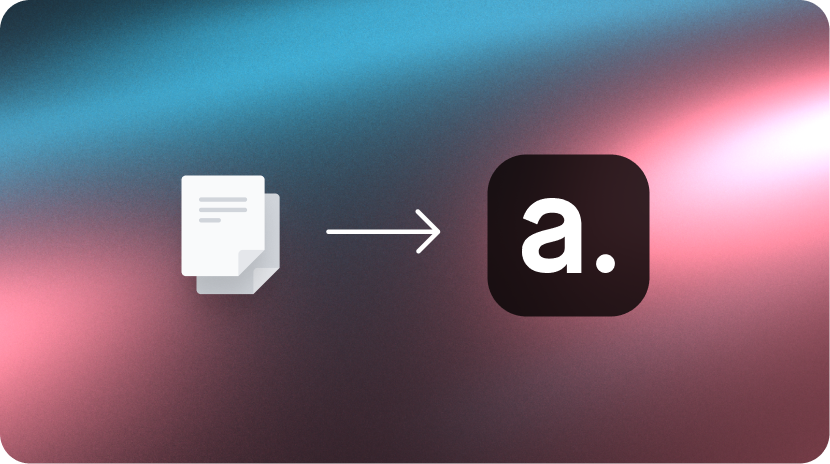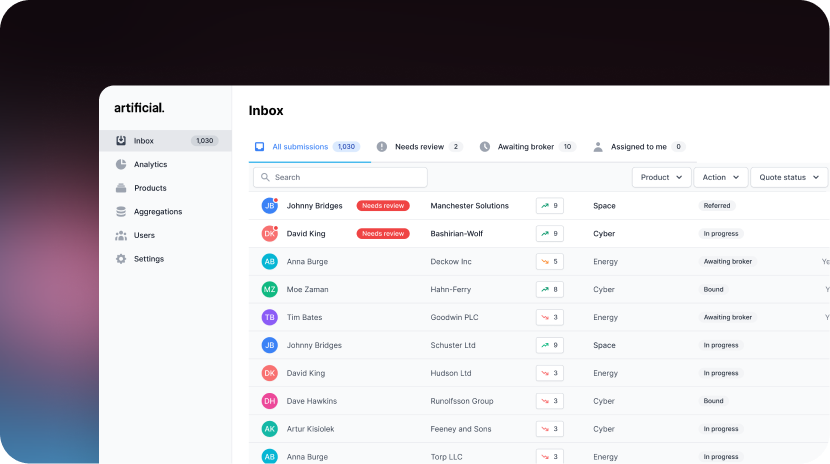The adoption of technology in insurance is rapidly increasing. As with any industry, it is essential that we study these advances with real-world use cases to gain more understanding of their short- and long-term benefits and to minimise the risk for businesses.
It is a misplaced fear that the advancement of technology means a reduced need for human expertise. In fact, throughout history humans have harnessed technology with great results. We believe by working together, human-computer collaboration will be a huge success story in the insurance industry.
The need for human-computer collaboration is becoming increasingly accepted by business; research by Capgemini shows the majority of organisations now believe machines to be complementary to humans. They also believe AI in particular will make complex or difficult jobs easier for employees.
We made a similar case on our blog earlier in the year, commenting that 'AI is likely to remove some of the more low-value and onerous tasks currently undertaken by employees, freeing them for more interesting work using skills that AI is unlikely to ever replicate.'
A recent study in the medical field demonstrated that human-computer collaboration increases the efficacy of medical diagnoses, particularly for junior clinicians. The research also shows that humans and technology working together are greater than either on their own.
We know similar advancements are also coming for the insurance industry. So how can humans and technology best work together to improve the sector?

Humans + computers = better than a human or computer alone
Humans have levels of emotional intelligence - that is, empathy and emotional understanding - which computers will almost certainly never reach (unless you believe science fiction). By contrast, machines are capable of making vast calculations and analysing large data sets extremely quickly, and can perform complex tasks with minimal intervention.
Human emotional intelligence will be an essential skill in insurance in the years to come, as computers are deployed for the majority of manual and repetitive tasks. In one report, Capgemini outlines the need for this skill in business:
"Emotional intelligence is one area that AI and machines find hard to emulate. It is important for employees and organisations to focus on those unique human cognitive capabilities that machines simply cannot master."
"Specifically, in the age of the smart machine, emotional intelligence skills will enable non-supervisory employees to stay relevant, take up more value-adding activities and jobs, and progress in the organisation."
Finding the middle ground
In life, the majority of people do not commune at either end of a spectrum. The middle ground is often where the most beneficial outcomes reside. Simply automating every task is not an efficient use of an insurer's time or money. Neither is rejecting technology and refusing to harness any of the plethora of software solutions available.
With a collaborative approach to insurance, technology negates the manual, tedious and repetitive tasks and allows humans to bring their unique emotional insight to bear where required.
The competence of an experienced insurance practitioner in the specialty insurance world cannot be matched with current technology, but it is far harder and more expensive to 'scale' human resources than technical ones.
The focus for insurance companies should be on applying technology to reduce unnecessary interventions and increase the amount of time spent by humans to add greater value to an organisation, instead of trying to replace them altogether.

Transparency brings trust for the underwriter
But what happens if an insurer adopts a new piece of technology, only to find out their underwriters don't trust it?
There are plenty of reasons to adopt transparent technology (particularly AI) in business, ranging from ethics to regulatory development. In the field of insurance, underwriters need transparency to ensure they are accepting or rejecting the right business and to explain their decisions clearly to brokers.
Human-computer collaboration stands to benefit underwriting when the technology is understandable, fair and reliable. If an underwriter is confident that the results given to them by a computer are correct, they are more likely to use it in the first place. If not, there's no point adopting the technology at all.
As in all relationships, trust is key. There may be an innate fear of technology that can manifest itself in many ways. What if the technology gets it wrong? Why did the computer make that decision?
This is where a collaborative approach reaps benefit again; by implementing a well-reasoned target accuracy metric in testing and development stages, the underwriter can be confident that the computer is making the decisions according to the right variables and with correct results when the product eventually goes live.
With technology that is fully transparent, the underwriter is able to review, validate and iterate on improvements as required, to a point where they’re happy to reduce the frequency and detail of their reviews.
And if an underwriter disagrees with the logic that the machine applies, they can use their intelligence and instincts to disregard the outcome. With transfer learning models underpinning the approach, these interventions allow the model to retrain and come to the 'right' outcome in future situations.
Human-computer collaboration improves customer experience
Customer experience will be improved with the adoption of fair, understandable technology. Expectation in the insurance market is increasingly focused on convenience, experience and personalisation, and the engagement of technology is a significant enabler of that goal.
To engage in a younger generation of customers - who account for two thirds of the population as of 2019 - insurers must create 'relatable offerings available for purchase with a few online clicks.'
One clear customer benefit to human-computer collaborative approach is faster and more efficient decision making and turnaround times. If a broker receives a quote in seconds from one underwriter who has automated their data collection and triaging system, they're more likely to return to them with repeat business over other, slower insurers.
Another benefit is increased transparency for the customer. Transparency doesn't just benefit the underwriter: beyond initial decision-making, greater transparency helps the underwriter's customers and other members of the value chain to understand why certain decisions have been made.
For example: if a broker is given a more detailed picture of the underwriter's appetite, including reasons why the submission was or wasn't accepted, it helps them to refine the enquiries they make and therefore minimise the time spent on opportunities that they know are not within appetite.
And for the broker's customer, whilst it is never a positive experience to hear 'no', being given the reasoning behind a decision makes the overall experience fairer and more positive (despite the undesirable outcome). By building a reputation for being transparent and fair in the treatment of customers, further opportunities will be forthcoming for the broker, and in turn the underwriter.

The least experienced underwriters will gain the most from technology support
Capgemini reports that the digital talent gap is widening for 58% of insurance companies. This means the next generation of underwriters must be more technically adept than their predecessors, but that there are not currently the skills available.
Certain types of technology have the potential to inform and educate junior underwriting staff more than those in senior positions. Machine learning models, for example, continue to learn as decisions are made and fed into the system. In underwriting, models could learn from the justifications given in relation to certain submission decisions.
These judgements can produce either uncritical conformity or collective intelligence depending on the relevant scenario. Standardisation can help to improve the performance of a portfolio whilst collective intelligence supports more accurate decision making.
This insurance 'hive mind' can then be used to support junior underwriters: instant access to the experience of all underwriters in an organisation helps to train well-rounded and technologically astute staff.
Analysis informing decisions
By presenting transparent decision outcomes, junior underwriters can review and understand the type of logic applied to decisions and why, so they learn to 'think' like an underwriter from collective experience.
This should not be viewed as a potential to stifle creativity. In this situation, any underwriter could formally 'question' the output of a piece of technology via an approvals process, which presents decisions for the consideration of subject matter experts. This supports growth whilst also reducing the chances of poorly informed changes being applied without review.
Junior staff will greatly benefit from educational support provided by the technology, and the more senior individuals will spend more of their time developing business relationships thanks to the reduced need to directly monitor performance. Data-driven insights and analytics mean all relevant metrics can be presented to senior staff, identifying any areas for attention or concern.
When engaging with potential new staff, it is abundantly clear for insurers that the process of sifting through multiple documents for a single risk and manually keying in data from paper is not an appealing proposition.
By removing the unnecessary and repetitive tasks from the job, roles become increasingly attractive and draw access to a wider talent pool. Those with technical acumen who may have previously overlooked careers in insurance may be more interested, and staff who become frustrated at the basic administrative nature of the role are more likely to stay and progress within the organisation.

Insights derived from tech can inform underwriting performance
Around 75% of companies interviewed in a recent report say that 'AI brings new insights, improves data analysis and helps them make better decisions.' Technology - particularly AI and machine learning - is certainly capable of providing sophisticated analysis of an underwriter's risk portfolio, but without human oversight and emotional intelligence, its potential cannot be reached.
For example, an AI can triage incoming submissions, manage workloads and improve operational performance. In this instance, simple automation rules are first used to reduce the frequency of unwarranted interventions and their associated costs. This can be followed by an AI scoring algorithm which provides insight to the underwriter, such as assessing a submission's degree of similarity to past successful historical submissions.
Retrospective analysis of portfolio performance can help to provide underwriters with a deeper insight into performance, and can suggest rating changes and key risk factors not currently considered that could potentially deliver better results for risks written in the future.
Such algorithms are complex and involve calculations and analysis that a human could not do in the same amount of time. This is a perfect example of technology augmenting the work of an underwriter rather than taking it away. AI and automation can equip the human with novel insights which they can use for improved decision making.
Conclusion
The insurance industry stands to be radically improved by technology, but only if companies combine the speed and analytical capabilities of computers with the best of human underwriting expertise. The ideal collaboration will inevitably lead to in-depth insights, improved performance and better customer experience.
But a human-computer partnership will only work to its full potential if insurers implement new software thoughtfully and with purpose; solutions should be carefully considered before adoption to ensure that they are fair and understandable to both the underwriter and their customers. And if the technology is not transparent, any new implementation will only put off the underwriter and be unsuccessful.
Support should also be given to junior underwriters whose way of working will eventually be entirely different to that of their superiors. They must be trained and equipped with the skills necessary in order to make human-computer collaboration work, and if insurers get this right, they are sure to reap the benefits of a new generation of technologically adept underwriters.
Ultimately, the only way the insurance industry can progress to its potential is if humans and computers work better together.
For more information on how Artificial could help your underwriters, contact us or visit our website.


